February 23, 2020
Diving St. Thomas October 2019
It’s always a treat to experience a place one has never been to, and for us the US Virgin Islands were such a place. The islands consist of St. John, St. Thomas, and St. Croix. Fairly close by are the UK Virgin Islands. They are all part of the same bundle of small islands between Puerto Rico to the west and St. Martin and the beginning of the chain of Caribbean islands to the east that then curves down all the way to South America. It’s easy to see why this string of inviting small islands was once teeming with pirates and all sorts of fortune seekers.
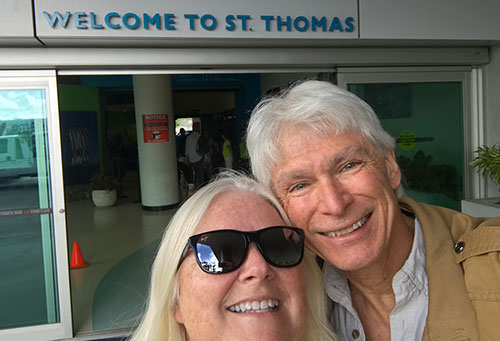
If it weren’t for the airlines' steadily sinking levels or service and reliability, the ever increasing cost and nickel-and-diming, and just their general obnoxiousness, it’d be remarkably easy to get to the Virgin Islands. No passport needed. No grumpy immigration. You deplane at St. Thomas airport and are greeted by friendly people, free Cruzan Rum samples, island music and most of the same amenities as in the contiguous United States. Luggage arrives quickly, no brigades of hustlers trying to sell you this and that.
Our friends had arrived a couple of hours earlier, picked up a rental van, checked in at the Margaritaville Wyndham resort where their time share ownerships grants them access to wonderful housing, and had braved traffic to come pick us up. It’s good to have great friends.
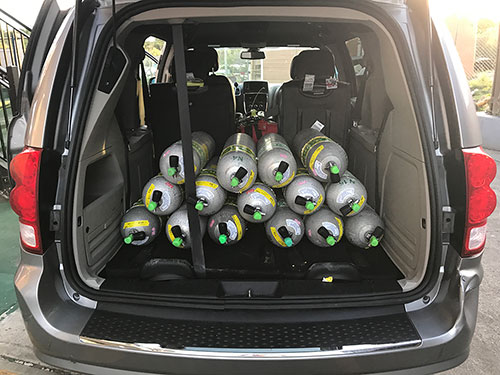
First stop was to pick up Nitrox tanks which, supposedly, are only available at one dive shop on the island. Upon checking pressure and oxygen content of every one of them, we loaded 16 tanks into the van and paid the rather exorbitant charge consisting of a nitrox fill, tank rental and tank off-site charge. Then starving, and sweaty from both the island heat and humidity and hefting the tanks, we stopped at the close-by Tap & Still bar & grill for some cheap whisky and truly excellent burgers, fries and chicken sandwiches, all served in individual greasy little paper bags.
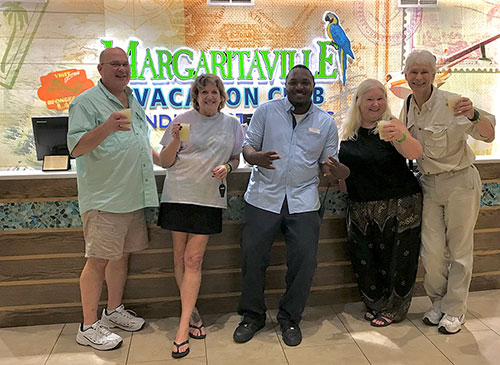
It gets dark early in the Virgin Islands in the Fall, like 6PM, and so it was pitch-black by the time we reached the impressive, gated Margaritaville complex on the beach and extending into the hills. We were greeted with, what else, Margaritas, hefted half of the 16 tanks into a storage room, then hopped on an elongated golf cart to be brought up to our duplex on the hill. Our two-story home away from home for the week was nice and modern, but also stiflingly hot. So we went cooling off in a wonderful red-light infinity pool higher up on the hills while the A/C kicked in. Which it wasn’t, and never would, and so we had to pack up again and move to another unit.
Being spoiled from having spent so much time at “dive camps” where sleeping accommodations are just steps away from the dock and boats, the logistics of getting gear from a place high up on the hills down to the parking lot and into a van, then driving up and down many more hills on the other side of the road to a dive shop on the other side of the island, were daunting. As was finding the grandly named but actually charmingly rustic Admiralty Dive Center in the old french part of Charlotte Amalie harbor.
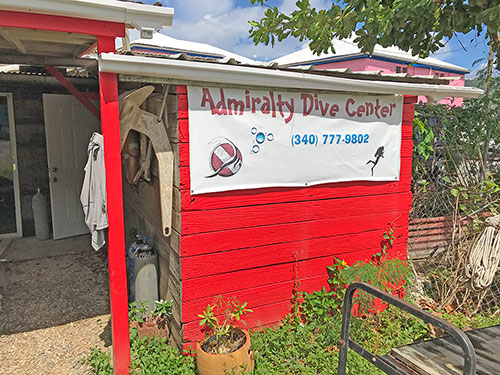
Then unloading everything and getting it onto the dock and into the nicely equipped dive boat.
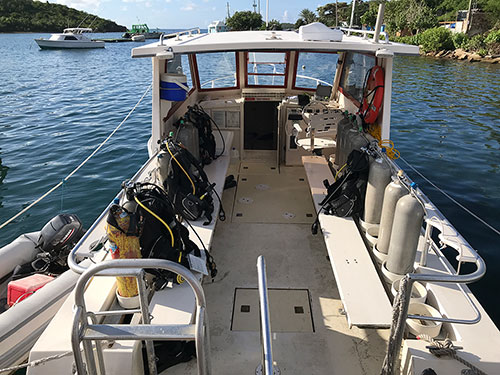
The island of St. Thomas seems to sit on top of a mostly flat expanse of sandy and largely featureless shallow sea bottom that rarely drops below 80 feet. That means dive sites are mostly wrecks, occasional underwater hills and rock outcroppings, some reefs, and sites close to shore where there can be coral fingers with sandy chutes in between them. The water was a balmy and consistent 86F, allowing wearing nothing but swimwear or perhaps a rash guard on top. We dove a variety of US Navy barges dating back to WW2, usually sitting in waters between 40 and 60 feet. Those had served as troop quarters and later sank, making for rather attractive dive sites.
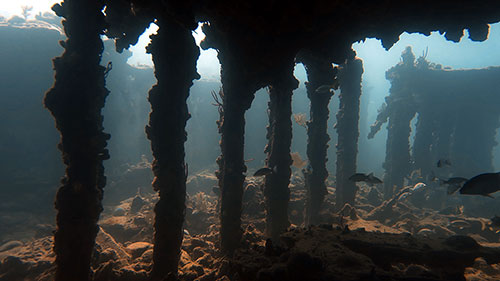
Our dive boat was unique in that it had a dive pig on board. Yes, Captain Jerry brought his pet pig Abby to ride along. Abby was well-behaved and did not seem to mind the boat trips at all.
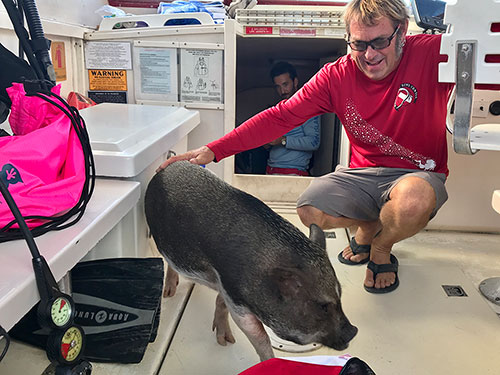
We had one scary incident. A lady in her early 60s had joined us for the morning dives. She had seemed somewhat uneasy from the start, though she described herself as an advanced level diver. The dive was to a 90 foot sandy bottom with a slightly elevated reef. The divemaster noticed her acting a bit strange and tended to her. She had enough air, but since it was a deep dive he guided her up. She, however, ascended too fast and then apparently lost control of her buoyancy and did not even make the 15-foot safety stop
Back on the boat she seemed increasingly uneasy. The captain and divemaster questioned her, helped her out of the sun and out of her wetsuit. This did not help and she vomited twice. The captain then aborted the trip and rushed the boat home, calling medical assistance and whoever else needed to be called in such a case. At the dock, the woman was helped up. She dragged one leg and had blotchy skin on her upper back. She was then lifted onto the dock and given 32% nitrox for breathing (no pure oxygen was on the boat). EMTs arrived with a gurney, questioned and examined her and then rushed her to emergency. Whew.
Below is a mapping log of one of our dive trips out of Charlotte Amalie on the Admiralty Dive Center boat with Captain Jerry Cowan.
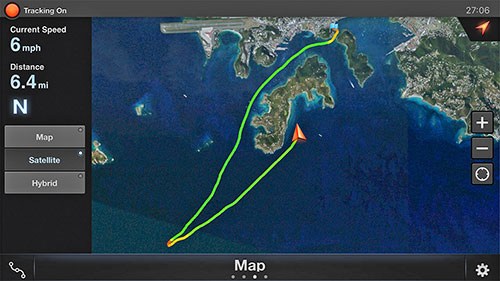
Having a rental van enabled us not only to make the trips back and forth from the place where we stayed to the dive shop and dock, but also allowed us to go grocery shopping and eating at restaurants without needed to call a cab. Driving on the left side of the road required some major adjustment with our designated driver constantly repeating her “stay left, stay left” mantra. She got used to it surprisingly quickly, but occasionally lapsed, making for some honking and embarrassment. Since all cars on the road seem to have standard lefthand steering one wonders why the US Virgin Islands haven’t simply switched to driving on the right side of the road long ago. Tourists, of which there are plenty, would be grateful, there’d be fewer accidents, and the logistics of switching would be relatively simple.
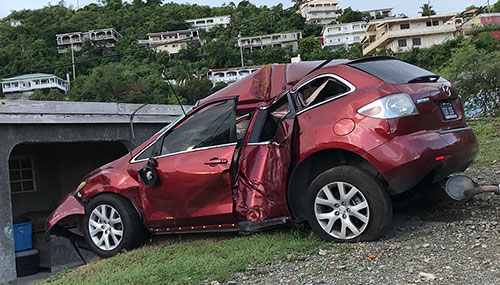
We went for a food run to one of the local supermarkets where prices were, on average, about 40% higher than in the US. Gas ran close to $4/gallon, almost twice what we pay back home in Tennessee. How do locals afford that? Are there two economies, one for tourists and expats, and one for locals? Everything else is also expensive. A taxi ride from our Margaritaville resort to the airport, which isn’t THAT far, is $58 per person, plus luggage fees.
Also interesting is that the US Virgin Islands have no sales tax to help pay for an elaborate infrastructure costly to maintain. The entire situation is unique. When one looks onto most maps, it’s difficult to find the US Virgin Islands. They are together with the UK Virgin Islands, just a group of small islands. St. Croix, which is also part of the US Virgin Islands is quite a ways away, whereas the island of St. John is right next door.
Compared to other Caribbean islands, not everyone is friendly. While we met many enthusiastic, helpful people, a good number were on the surly side, less than helpful, and seemingly quite disinterested in making customers and tourists feel appreciated, let alone welcome.
Overall, the diving was so-so. It’s mostly sandy bottoms, though there certainly are nice sites. That’s because the whole area is geologically a “back reef lagoon/shelf." Reefs here and there were formed when sea levels were at temporary stand-stills.
During our stay, the consistent 86 degree water made it unnecessary to even wear a wetsuit. I wore dive pants and a rash guard. We saw lots of life around and in the wrecks, and also interesting things like small schools of squids in the reefs surrounding islands.
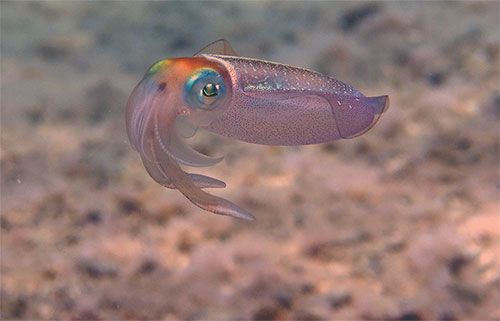
The most serious issue is massive smothering by phaeophytes algae, mostly the dictyota brownish mesh algae that is also all over the waters around the Honduran island of Roatan.
But whereas in Roatan dictyota is just the third-worst plague, at the Virgin Islands with its expanses of flat sea bottoms and reefs, it’s the primary threat, being virtually everywhere and covering almost everything. In addition, the unusually warm water have contributed to widespread coral bleaching.
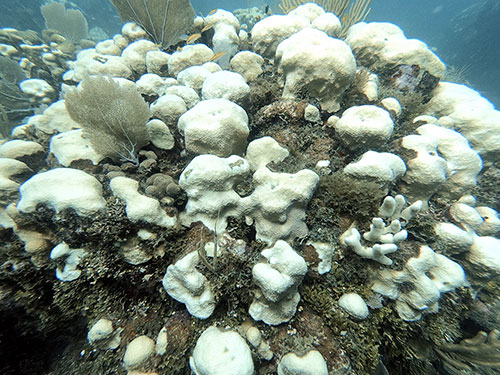
Memorable dives included “Packet Rock,” a pinnacle covered with yellowish-brown coral that makes for dramatic fly-overs. The name comes from steam ships of the Royal Mail Packet company that hit the rocks in the 19th century and sank here, spilling their cargos.
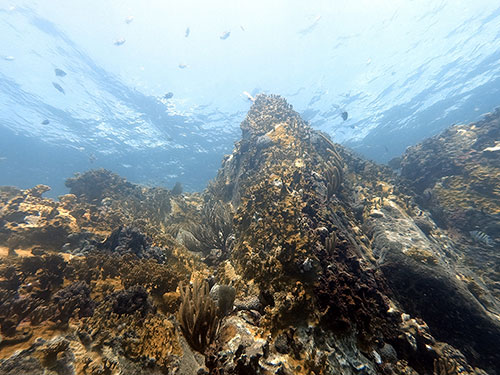
As the dive boat appraoches the famous rock you won't see it at first (just like all the sailing ships that have hit over the last 200 years), but eventually you see light yellow-brown color just beneath the surface, like someone poured mustard in the ocean. That is Packet Rock.
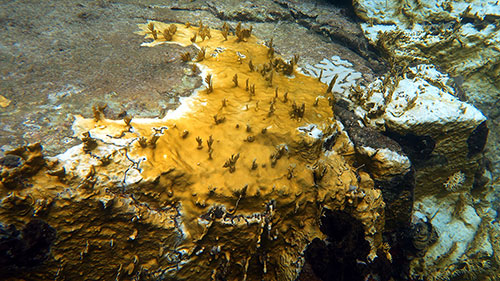
Packet Rock makes for an interesting dive site not only for its picturesque yellow pinnacles, but also for the wealth of roof tiles and thousands of broken pottery shards, and glass of all kinds that can still easily be found in sands and pebbles around the pinnacles.
Another fascinating dive was to the “W.I.T. Concrete,” a 400-foot concrete oil tanker sitting upright in maybe 90 feet of water.
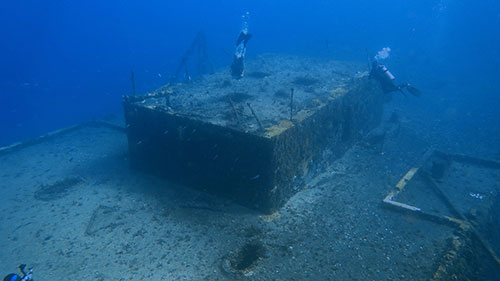
Some research revealed that the "W.I.T. Concrete" was most likely the "Concrete 2" YO-144 that was built in 1942 by Concrete Ship Constructors in National City, California. YO stood for "Yard Oiler." The YO-144 was renamed to YON-144, where the additional N meant she was not self-propelled, but moved by two tugs attached to each side. The YON-144 served at Yokosuka Naval Station in Japan, was later moved to the Philippines, and somehow ended up off St. Thomas.
And this is what the concrete ship looked like back in 1943:
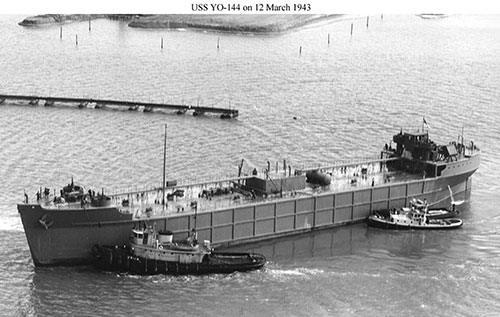
Overall, we did about a dozen dives off the coast of St. Thomas. Anytime one gets to go underwater is a treat, and if the scenery above ground is as dramatically beautiful as it is around St. Thomas with all if its islands, that goes double.
The waters, by and large, were blue and clear, the wrecks are all interesting and engaging to dive, we saw sharks on several dives, as well as turtles, rays, eels, groupers and much more. Diving, as everything on the island, is expensive. Even bringing our own (very expensive) nitrox, it still cost Carol and I $240 per day for just two dives each. Plus tips. That is on the border of what is still affordable for us.
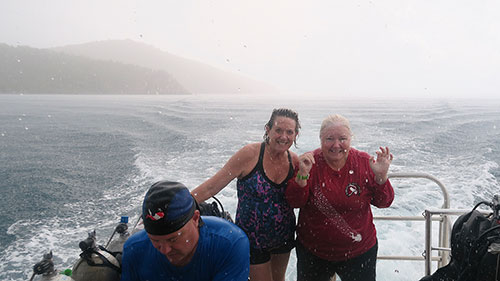
Posted by conradb212 at 5:30 PM








